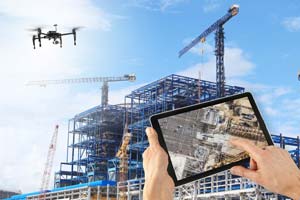Unlike other industries, the construction industry has been very slow to adopt new technologies and consequently has not undergone any major transformations within the past four decades. Technology has simplified the various tasks in this field of construction but it has not been able to achieve major gains in terms of productivity due to the lack of integration between applications.
In the U.S., for example, every other industry has been able to achieve huge gains in productivity within the past forty years except in the construction industry. However, this mediocre record seems to be in the process of being broken as profound innovations seem to be taking place.
As we look forward to discovering many more wonderful innovations in the construction industry, below is a compilation of some of the most exciting trends that are fast transforming this industry.
New Technological Innovations in the Construction Industry.
In this era of technological development, every sector has been greatly transformed through digitization. Though a good number of technological innovations have been recorded in the construction industry within the past decades (as can be seen in some of the world’s greatest cities where vertical construction is dominating), this sector has remained timid with digitization.
However, more and more construction projects and companies are beginning to incorporate intelligent machines, mobile devices tracking systems, and new software applications centered on BIM (Building Information Modelling). The most exciting of these innovations include:
- Drones: Unmanned Aerial vehicles (UAVs) or drones are machines equipped with cameras that are used to collect information in locations that are hard for humans to access.
These captured images and/or video footage from drones are increasingly being used by construction companies to assess the level of work advancement of an ongoing construction project through the use of software installed on the receiving end. Though this technology is still in its initial phase, it is rapidly gaining ground in the developed world.
- 3D Modelling: This involves mainly 3D printers and robotic constructors. Robots are increasingly being used for demolition works, placement of bricks, excavations, plastering, painting, and many other major tasks in the field of construction.
In the construction industry, 3D modeling involves the process of creating a mathematical representation of any object in the three-dimensional space using specialized software. More about this technological innovation and its benefits to the construction industry are outlined in the following link.
- Autonomous vehicles: The car assembly industry has recently gone into the manufacturing of autonomous cars that have innovated the art of construction.
Advantages and disadvantages of a technology-driven construction industry
Some of the striking advantages of introducing future technology into the construction industry include:
- Drones help us in scanning existing structures to identify maintenance areas that may not always be visible to the human eye.
- Sending a drone to inspect a construction site saves time and keeps the engineer on the ground instead of climbing scaffolds and navigating the potential hazards of a working site.
- The Skycatch drone can generate a 3D model of a site from which we can have geometric characteristics of our site such as the area and the volume of the excavation – elements that used to require a lot of human hours and stress to compute.
- The use of future technology in the construction industry is an innovation that can help any company to survive in a highly competitive environment where firms are finding it very difficult to compete especially in terms of prizes. Future technology helps in reducing costs and inefficiencies.
- The use of robots for demolition is a vital risk mitigation aspect of new technology in the construction industry.
Though the advantages are many and may seem very promising, some associated disadvantages that cannot be neglected include:
- The use of robots in the construction industry tends to increases the rate of unemployment.
- Robots are not as intelligent as humans, they can’t improve their jobs outside the pre-defined programming because they simply cannot think for themselves and this may make the task more expensive.
- The initial capital required to adopt such a technology can be too huge for a new firm.
Generally speaking, the rate of technological adoption in the construction industry has been very slow. But with the pressure of a challenging economic crisis across the world, companies are willing to innovate in order to be able to cope.
Despite the allusion that there is some kind of robotic construction workers and 3D printing homes in the horizons, that future is not quite around yet.
Our focus as players in this industry should be to disrupt existing processes and come up with new ones that will be better for companies, clients, investors; and above all, attract more talents.
By simply improving your project management, you may significantly and drastically cut costs and improve the overall value of the project.
The big question remains: Are you ready to embrace some of these innovations?

